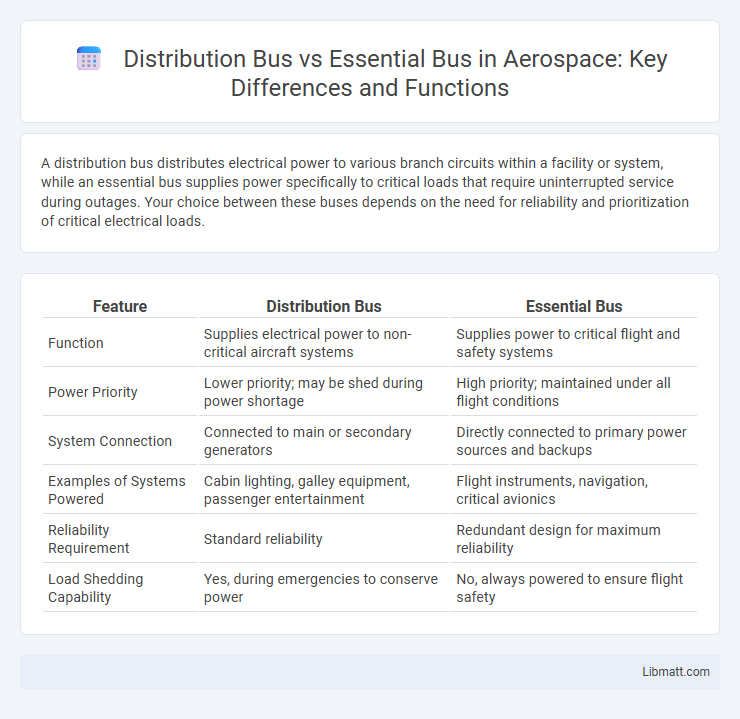A distribution bus distributes electrical power to various branch circuits within a facility or system, while an essential bus supplies power specifically to critical loads that require uninterrupted service during outages. Your choice between these buses depends on the need for reliability and prioritization of critical electrical loads.
Table of Comparison
| Feature | Distribution Bus | Essential Bus |
|---|---|---|
| Function | Supplies electrical power to non-critical aircraft systems | Supplies power to critical flight and safety systems |
| Power Priority | Lower priority; may be shed during power shortage | High priority; maintained under all flight conditions |
| System Connection | Connected to main or secondary generators | Directly connected to primary power sources and backups |
| Examples of Systems Powered | Cabin lighting, galley equipment, passenger entertainment | Flight instruments, navigation, critical avionics |
| Reliability Requirement | Standard reliability | Redundant design for maximum reliability |
| Load Shedding Capability | Yes, during emergencies to conserve power | No, always powered to ensure flight safety |
Introduction to Distribution Bus and Essential Bus
A distribution bus is a crucial electrical component that channels power from a primary source to multiple circuits within a system, ensuring efficient energy allocation across various loads. An essential bus, in contrast, prioritizes critical systems by maintaining continuous power supply even during contingencies or failures, often supported by backup sources like batteries or generators. These buses are fundamental in complex electrical networks such as aircraft or data centers, where maintaining uninterrupted power to vital equipment is paramount.
Key Differences Between Distribution and Essential Bus
Distribution bus serves as the main power distribution point within an electrical system, delivering electricity to various downstream circuits and loads. Essential bus is specifically dedicated to critical loads that require an uninterrupted power supply, often connected to backup power sources such as batteries or generators. Key differences include their role in the system, with distribution bus managing general power distribution while essential bus ensures continuity for vital equipment during power disruptions.
Functions of a Distribution Bus
A distribution bus functions as a crucial electrical hub that channels power from the main source to various circuits and equipment within a system, ensuring efficient power management and load distribution. It isolates faults by enabling selective disconnection, maintaining system stability and continuity on other circuits. Your electrical system relies on the distribution bus to manage multiple loads safely while coordinating with essential buses to prioritize critical power supply during emergencies.
Functions of an Essential Bus
An essential bus in an aircraft electrical system ensures continuous power supply to critical components such as avionics, flight control systems, and essential lighting, maintaining system integrity during failures. It isolates essential loads from non-critical ones, prioritizing power distribution to vital equipment for safe operation. The essential bus typically receives power from reliable sources like the main engine-driven generator or an auxiliary power unit to guarantee uninterrupted functionality.
Importance of Electrical Bus Systems in Power Networks
Electrical bus systems are critical components in power networks, facilitating the efficient distribution and management of electrical power. The distribution bus serves as a centralized node that connects multiple circuits and loads, ensuring seamless power flow to various sections of the network. Essential bus systems prioritize reliability and continuity, maintaining power supply to critical loads during faults or maintenance, thereby safeguarding your infrastructure and operational stability.
Applications of Distribution Bus in Industry
Distribution buses serve as critical nodes in electrical power systems for distributing power to various industrial loads, including machinery, lighting, and control systems. Their applications in industry encompass providing reliable and scalable power distribution to manufacturing plants, processing facilities, and industrial automation systems, ensuring continuous operation and minimizing downtime. These buses support efficient load management and facilitate integration with switchgear, transformers, and protective devices, optimizing overall electrical system performance.
Applications of Essential Bus in Critical Systems
Essential buses are crucial in critical systems such as hospitals, data centers, and emergency response facilities where uninterrupted power supply is mandatory. These buses prioritize power distribution to vital equipment including life-support machines, communication networks, and security systems, ensuring operational continuity during outages. You can rely on essential bus systems to maintain stability and safety in mission-critical environments.
Reliability and Redundancy in Bus Systems
Distribution buses provide high reliability by segmenting electrical loads, minimizing the impact of faults through isolation techniques. Essential buses incorporate redundancy schemes such as dual power sources and automatic transfer switches to ensure continuous power supply to critical systems. Both bus types prioritize minimizing downtime, but essential buses emphasize fail-safe operations for vital equipment in aerospace and industrial applications.
Maintenance and Safety Considerations
Maintenance of distribution buses requires frequent inspections and thermal imaging to detect loose connections and prevent overloads, ensuring reliable power delivery. Essential buses demand rigorous testing and redundancy checks to maintain uninterrupted power to critical systems, minimizing downtime risks. Safety protocols for both include stringent lockout/tagout procedures and arc flash hazard assessments to protect maintenance personnel.
Choosing Between Distribution Bus and Essential Bus
Choosing between a distribution bus and an essential bus depends on the criticality and load type in power systems. A distribution bus serves multiple non-critical loads with varying demand patterns, ensuring efficient power allocation across a network, while an essential bus prioritizes power supply to critical loads that require uninterrupted service, such as emergency systems and essential equipment. Selection criteria should focus on load importance, reliability requirements, and system redundancy to maintain operational stability during faults or outages.
distribution bus vs essential bus Infographic

 libmatt.com
libmatt.com